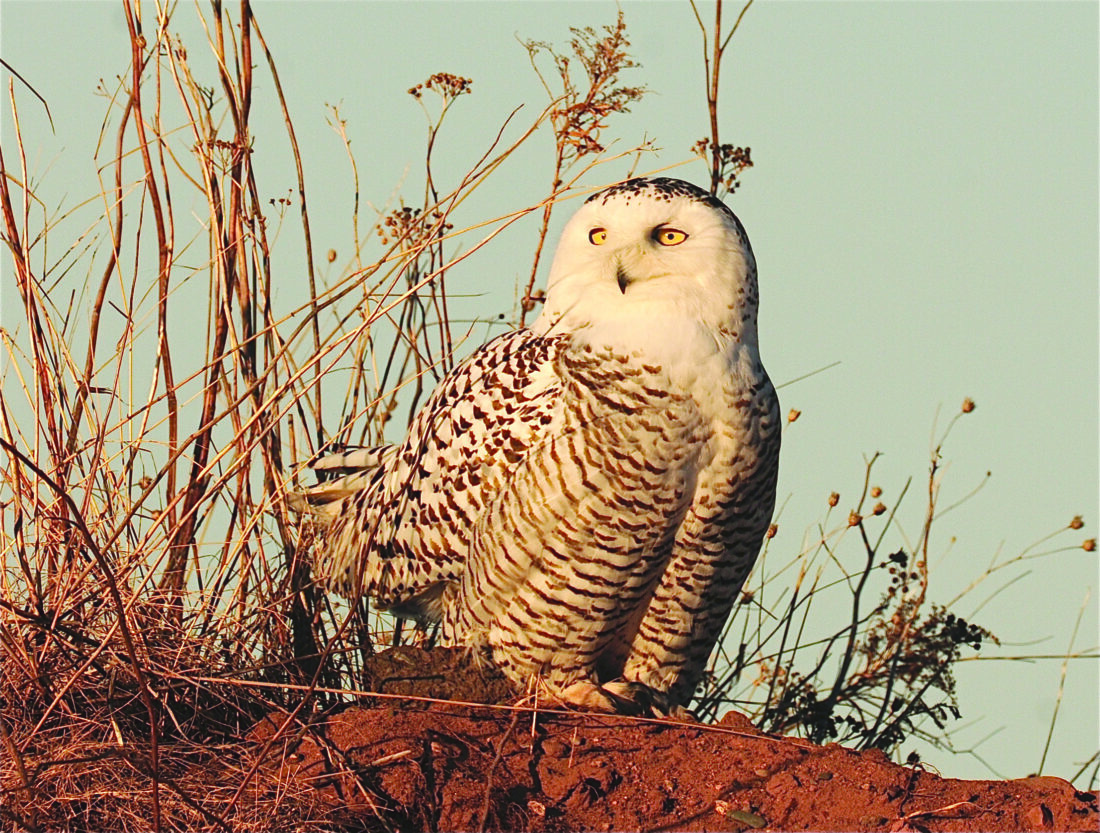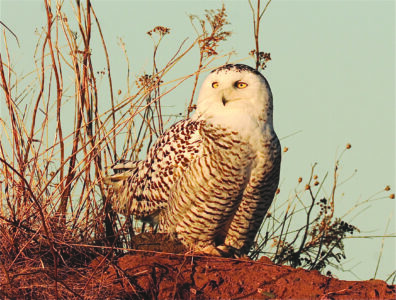What’s Flying: Christmas bird counts being planned

STEWART
“Autumn shows us how beautiful it is to let things go.” — Unknown
- A snowy owl looks on. (Scot Stewart photo)
The autumn leaves have all but let go for this year, with just a few lingering Norway maples in neighborhoods in Marquette County and browning northern red oak leaves across the area. The bare trees do provide a chance to see the true lay of the land with all its gullies and hidden hillsides and appreciate the often-rugged terrain of some of the surrounding hills in Marquette County.
Hooded mergansers have been around in Marquette County all year and at least one has been a regular between the piers and the old Ore Dock in the Lower Harbor of Marquette, often hanging out in the old pilings alongside the ore dock. However out at Teal Lake in Negaunee a check of the waterfowl last Tuesday, there were 54 hooded mergansers out on the water with 179 common mergansers. With lake ice beginning to form, they may not be around too long.
Swans, both trumpeter and tundra have stopped at many sites along Lake Michigan this past week. They have been seen at the mouths of both Ford and Whitefish Rivers. Peninsula and Portage Points were also stopping off points for them, with 36 seen at the former site south of Escanaba. Many trumpeter swans will continue at open water sites in Manistique and near Chatham at Trout Lake in Alger County. Virtually all the tundra swans stopping in fall in the Upper Peninsula will continue on to favored winter locations, mostly in the Chesapeake Bay area on the Atlantic.
Marquette’s two harbors have had a good variety of other waterbirds species this past week too. As many as 41 long-tailed ducks have been followed as they have foraged daily between Founders’ Landing and the Lower Harbor ore dock. Horned, red-necked and western grebes have been in the mix there too, although it appears the western grebe, a rare vagrant to the area left early in the week. Common golden eyes, buffleheads and mergansers have also been there along with the resident mallards.

A snowy owl looks on. (Scot Stewart photo)
The Upper Harbor in Marquette has been less crowded, but still very interesting with several vagrants. A harlequin duck has continued there, occasionally moving right into the marina area for great looks. It has female-type plumage, like that usually seen here, especially in the fall. On Tuesday a really rare red-throated loon was there on Tuesday near the breakwall leaving the area by late afternoon.
Also seen at Presque Isle Tuesday was a Townsend’s solitaire. Normally a resident of the Rocky Mountains, in winter they expand their range to the eastern edge of the Dakotas and Oklahoma and sometimes wander even farther eastward. They are unpredictable visitors to the U.P. and have been seen most often in Copper Harbor, Marquette, and at Whitefish Point. The fact that many good birders search all three locations probably has much to do with finding them there,
Slender, robin-sized birds, they usually seek out smaller fruits like mountain ash, smaller crab apples, winterberry, and introduced fruits like buckthorn and Russian olive. Because they are mostly gray with yellowish wing bars, they are often difficult to spot but they do have a habit of zooming up to larger trees to digest fruits and can often be spotted there first.
They regularly seek out juniper trees and bushes too for their ripe bluish-black fleshy cones. Some planted at Presque Isle and McCarty Cove may be good places to check out to see it if it sticks around. Several homes in Marquette have large juniper bushes that have attracted the solitaires in the past and can be observed from the street. Several have been seen for long periods feeding on crab apples like the ones at the west side of the Holy Cross cemetery in Marquette and at homes with winterberry bushes.
Snowy owls continue along the Lake Superior shoreline in Marquette, especially between Picnic Rocks, where they often roost during the daytime, and Upper Harbor at Presque Isle. The edge of Lake Superior in Marquette usually provides a near perfect wintering site for snowy owls, with ducks (if the water is open in the Lake’s harbors), pigeons, cottontails, and smaller rodents like deer mice and meadow voles.
Perhaps the most striking bird seen in the Upper Peninsula this past week has been a male painted bunting at a feeder in Brimley, over in Chippewa County. Truly a vagrant out of its normal range, it is usually found between South Carolina to New Mexico in summer, and normally as far north as Kansas. A few have popped up in the U.P. over the years, but rarely in male breeding plumage. About the size of a goldfinch, males have blue heads, red eye rings, rumps, and breasts, and green plus yellow backs. Reported on eBird for Chippewa County, as always it will be interesting to see how long it remains in the area as more wintery weather draws closer.
The Christmas Bird Counts are coming up next month and planning is already underway. Search “Audubon Christmas Bird Count,” then “Join,” and check the areas nearby or close to holiday stops for details on when and exactly where they will be held. Counts will be held between Sunday, Dec. 14 and Jan. 5. Because of the in-between-times this year, many will be a little closer to Christmas than normal. Both Marquette’s and AuTrain’s will be held on Dec. 20 this year. More information can be found on the site and here in weeks to come. In the meantime, plenty of beautiful birds, late fall leaves, and ice formations await!


